Product marketing is usually described as the driving force behind selling a product.
It’s all about understanding the customer’s wants and needs and fulfilling them through innovative and intriguing products. Sometimes, the customer doesn’t even know they need your product until it’s marketed to them. And that’s the art of product marketing.
So if you think you have fantastic ideas and want to get them out there to a receptive audience, you need to implement product marketing into your business processes.
Read on to find out more about what product marketing is, and how to implement it.
What is Product Marketing?
Put simply, product marketing is the process of bringing a product to market. It involves an understanding of the product, and more importantly, the market into which it’s being released. Utilising strategic marketing techniques and social media platforms, the aim is to boost demand for the product and, therefore, the revenue you earn from it.
Because although you believe you’ve got the best product out there, sometimes the rest of the world still needs convincing.
That’s where product marketing comes in. It allows you to understand better the market and your buyer persona – who’s buying your product. This is particularly useful if you’re a new business startup or launching a new product range.
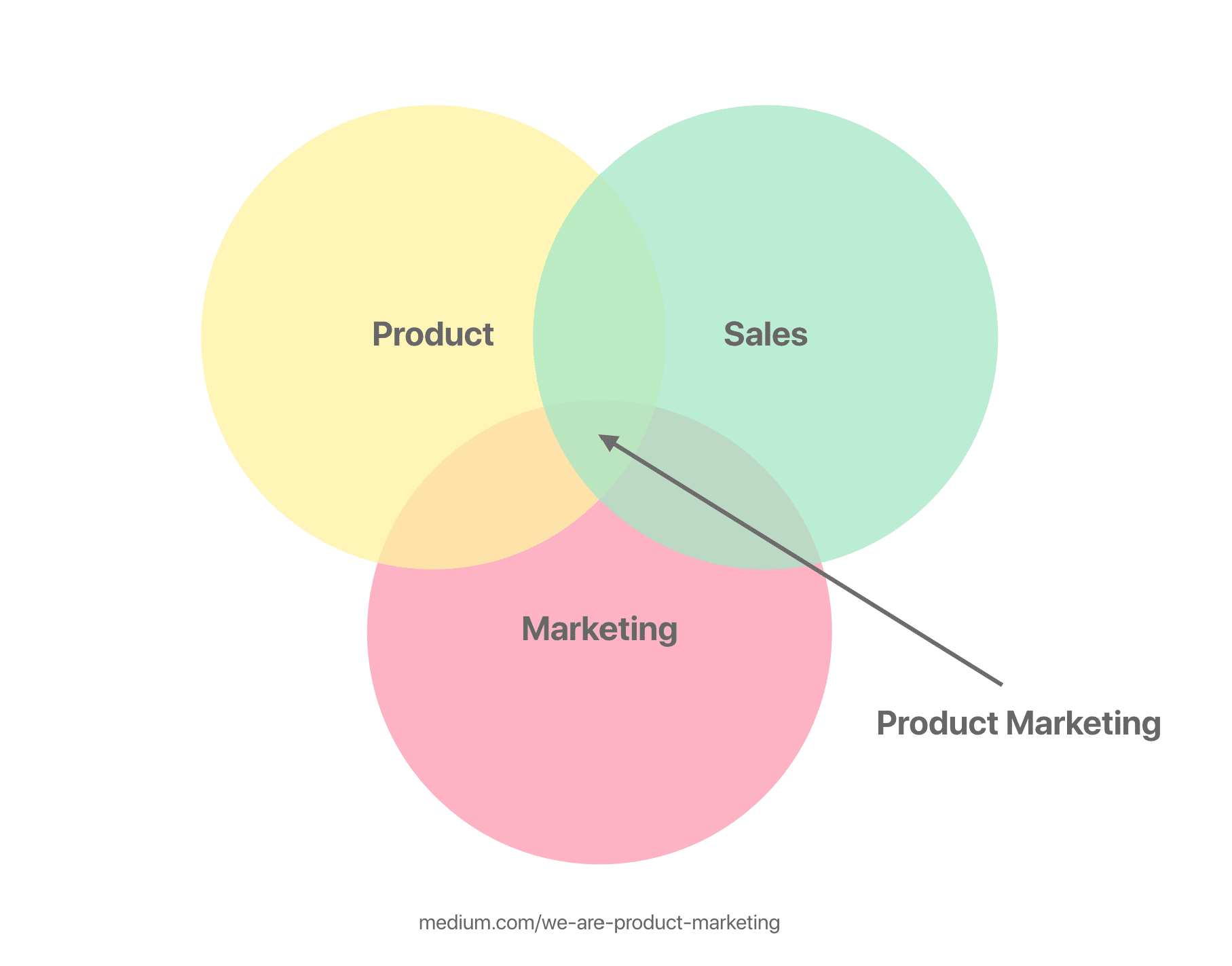
This diagram further explains the three main elements that product marketing entails. The product, sales, and marketing.
What’s more, understanding your audience is the backbone of product marketing. For instance, business communications software companies like RingCentral have tackled an issue for many businesses across the globe. That being connecting teams virtually, now that many people are working from home.
Companies can communicate effectively and efficiently using RingCentral’s platform. They can also tie in their other apps, such as Gmail, so they don’t need to keep flicking from one app to the other. This shows that RingCentral understands customer’s pain points, and continuously adds new features to improve the platform.
The Responsibilities of a Product Marketer
A product marketer has a number of responsibilities all of which are integral to successfully launching the product into the market. A study by Product Marketing Alliance discovered that 92% of those surveyed said that one of the most common tasks they worked on was messaging and positioning. We’ll go into detail later about what the two entail, and how you can implement them.
But the responsibilities of a product marketer go far beyond messaging and positioning for the product. Here’s a look at some other responsibilities of a product marketer:
1. Conducting market research.
One of the most important parts of a product marketer’s job is conducting market research. This includes research that needs be done before the product’s launch, such as:
- Who is the current market leader?
- Who is the target audience?
- What are some pain points of the customers?
- What are their defining features?
- Did they choose your competition over you, if so, why?
- How do they think you can improve?
Market research can be split into four categories; market research, buyer persona research, win/loss research, and case studies.
Market research covers the market’s size and value, and persona research looks into the customers within the market. Meanwhile, win-loss research looks into competitors, and case studies are positive reviews from customers about your product. Customer reviews are essentially free marketing! And the best kind – from the consumers themselves. Where you can, always try to encourage happy customers to leave feedback.
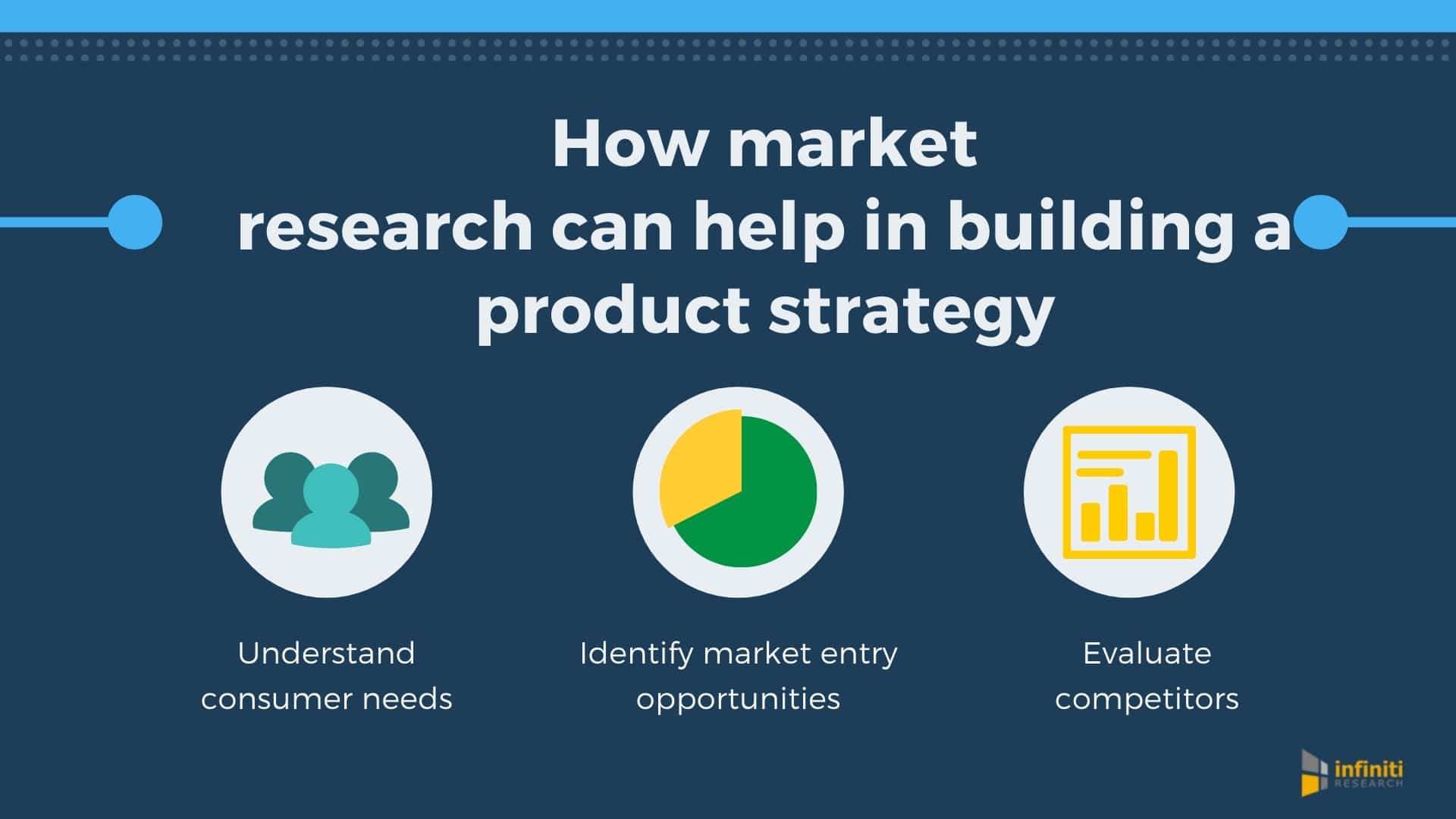
2. Product roadmap planning.
When it comes to roadmap planning, product marketers typically use customer success stories and industry data to create an effective plan. So, from the market research collected, you can pick out certain patterns and trends to determine what to include in your roadmap.
For example, RingCentral recently re-engineered their desktop app from the ground up, to give their customers an even better user experience. It’s easy to use and can be accessed through any mobile smart device.
So, if customers are eager for an updated version of your product with new features, when should you create the new version and release it? And if you’ve already got the product scheduled for release in January, is there any reason why you should wait or bring it forward, according to your research?
Designing a coherent roadmap is key to launching a product, as it gives you a better idea of the dates you are working towards, and what the plan of action is before, during, and after the launch.
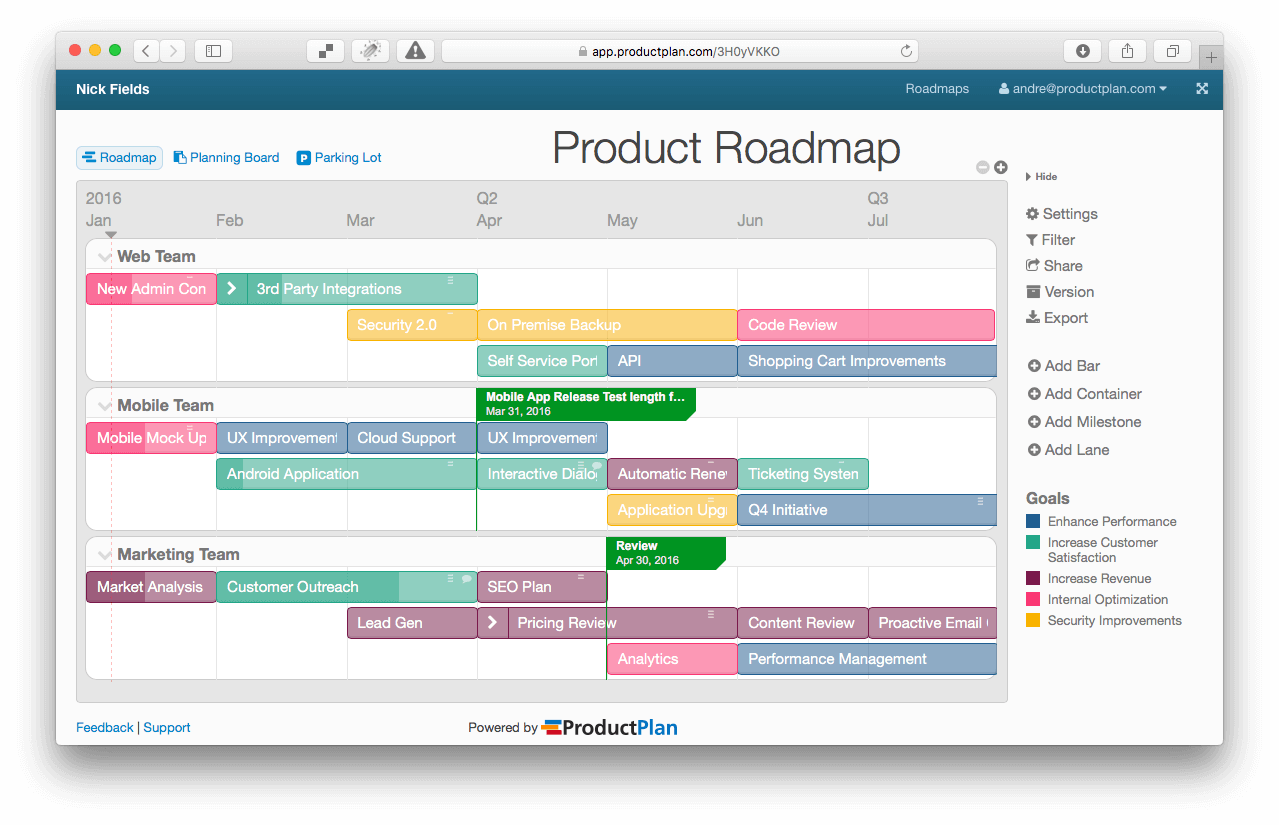
3. Creating the product marketing strategy.
Another responsibility for the product marketer is to create a product marketing strategy. This incorporates everything you’ll need in the steps running up to the launch, as well as the launch itself. The strategy should also include post-launch marketing and tactics to ensure your product stays relevant and above your competitors.
Having a strong product marketing strategy can make all the difference when your product finally hits the market. That’s because you will have already prepared social media posts, press releases, and other marketing forms to push your product to the front of your customers’ minds.
Benefits of the Product Marketing Process
The product marketing process comes with many benefits, which is why so many businesses across the globe strive so hard to get it right. When done correctly, product marketing:
- Ensures product-market fit – Makes sure your product is relevant to your target audience and works within the current market.
- Helps to understand competitors – Gives you a deeper understanding of competitors and allows you to stay competitive in an ever-changing consumer climate.
- Determines the best pricing for the product – Enables you to research the market and your competitors to determine the best price.
- Generate greater product demands – Uses demand generation marketing to drive awareness and interest in your product.
- Helps to develop an understanding of the product – Makes sure you and the team have a great understanding of the product, including its benefits and features, and what makes it different from competitors.
Product marketing helps to boost the business overall, not just the product. One successfully launched product can put your business on the map. Take the beauty and skincare industry, for example. Sometimes it takes one of their products to go viral online and on social media before their brand is acknowledged as a whole.
Here’s a look at the viral cycle, and the process in which a product “goes viral”:
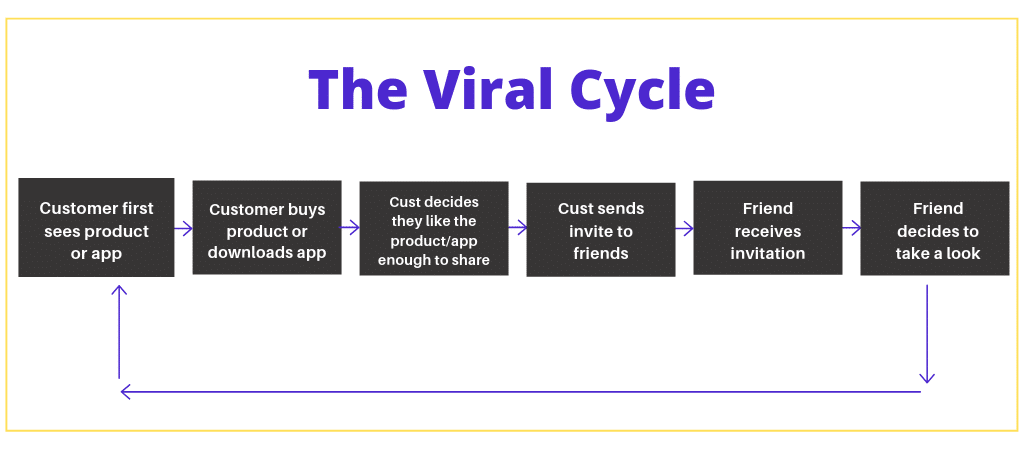
Hiring a strong social media team who reply to each customer and involve themselves in product discussions will also help establish your brand.
Product Marketing Vs. Conventional Marketing
Conventional marketing encompasses everything, from promoting a brand to advertising a Black Friday sale. This can be wide-ranging to grab a new audience and is not necessarily used to promote an existing audience.
For example, a SaaS (software as a service) marketing method is usually offering free trials. A company like RingCentral may offer a free trial of their premium RingCentral Office alternative to standard level customers. Those standard customers may enjoy the many additional benefits of the upgraded version and stick with it.
Product marketing, on the other hand, is more strategic. It focuses on a certain product, or range of products, and focuses on driving demand and product adoption for an existing target audience. It covers everything from product launch to execution.
Typically, product marketing teams and traditional marketing teams work together to create happy, repeat customers. This is also where demand generation comes in.
Demand generation is an umbrella term for the marketing and sales initiatives that contribute to the customer’s journey. The goal is to create a structured and predictable sales pipeline that can help your business grow. It’s about creating demand and ensuring the right people see your product.
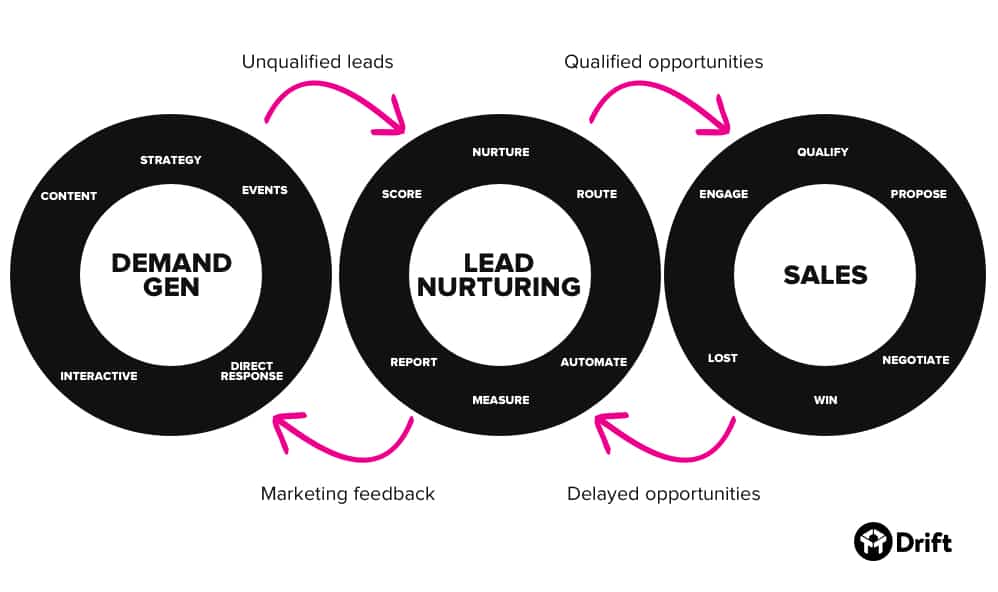
What is Product Marketing Strategy?
A product marketing strategy is the plan to get the product to market. It includes many key actions required pre-launch and post-launch, as well as during the launch. The strategy aims to prepare your team for your product’s release and establish a solid plan to propel your product to the top spot among your competitors.
Your product marketing strategy will help you better understand the market and your product’s potential within it. Once you have a successful product marketing strategy model, you can apply it to future product launches.
Even in the early stages of the product lifecycle, it’s wise to think about how you’re going to market your offering. The product lifecycle refers to the process of product conception, through to manufacturing, its release, and after.
If you know you’re onto something good at the product development stage, drop hints on social media and ask your customers what they’d like to see more of. Keeping the conversation on you and making sure they’re involved in the process makes them even more likely to support the product once it’s released.

What’s Included in a Product Go-to-Market Strategy?
1. Defining the target audience.
The first step in creating your go-to-market strategy is identifying the target audience for your product. Your target customers should be convinced that they need your product. Your goal is for them to make a purchase. So, you have to tailor your product to your target audience’s wants and needs, establishing the features that your audience is looking for.
For example, Apple has a reputation for innovative products. So much so that consumers will wait in line for hours just to be one of the first people to have it. They have become experts in creating products that consumers are convinced they need.
Tech companies have been making wireless, Bluetooth connected earphones for years. But when Apple released AirPods, it was still seen as a groundbreaking moment. Their customers were tired of wires getting in the way of their gym workouts and morning jogs. So, they saw a need for wireless Apple earphones and fulfilled it.
To keep themselves ahead of their competitors, they offer a personalised engraving service where users can customise their AirPods.
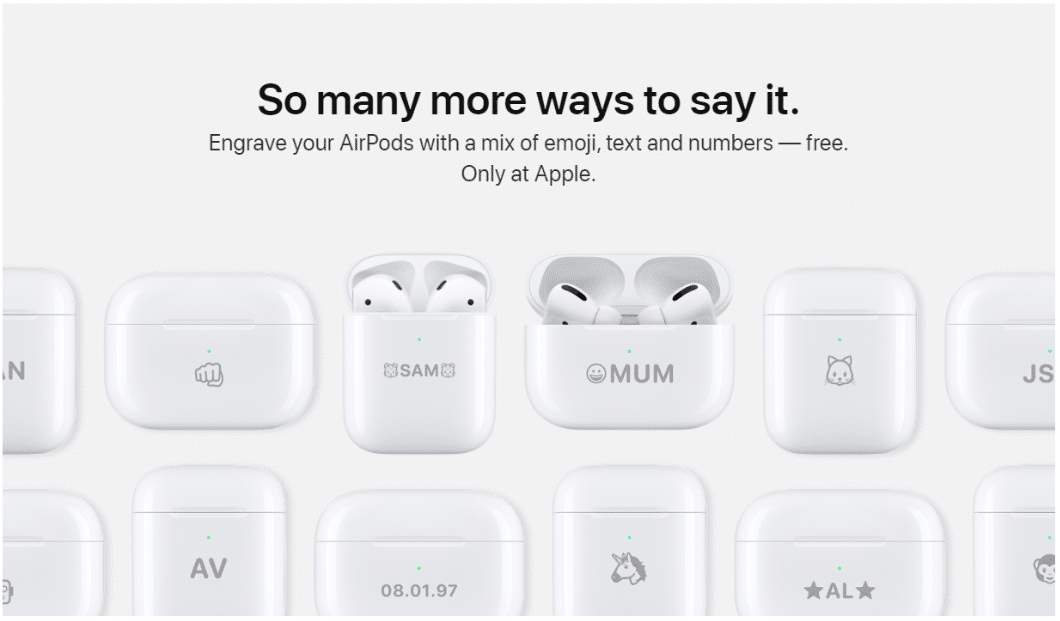
By no means is it a revolutionary idea, and other similar brands may also offer comparative deals. But because all of Apple’s products work harmoniously together, customers may be inclined to stick with Apple, rather than go with a less-expensive brand with fewer connectivity options.
By determining your customers’ needs and pain points, you’ll be able to ensure your product resonates with your chosen audience.
2. Determine product positioning and messaging.
Product messaging and positioning within the target market is crucial. Now you’ve learnt more about your audience and identified their wants and needs; you need to figure out where your product fits in.
This step includes your product story. Ask yourself:
- What are the important features you want to get across to your customers?
- What problem does this product solve?
- How will you include it in your product messaging?
- What does it do that your competitors don’t?
You need to set your product apart from your competitors through positioning and messaging. There are two templates commonly used for this, messaging hierarchies and positioning statements.
Messaging hierarchies
Messaging frames the product in a context that customers care about. Here’s an example of the message hierarchy for car manufacturers, Volvo:
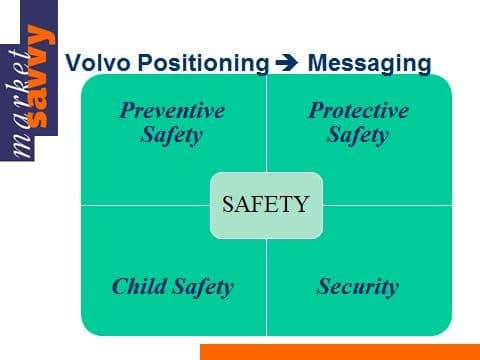
The core value, ‘safety’ has four attachments to it. Preventative safety, protective safety, child safety, and security. This can then be used to develop consistent messaging in your outbound product marketing.
So, in this example, preventative safety measures to be included in the product messaging may be:
- Anti-lock brakes
- Collision warning
- Roll stability
- Rear fog light
Positioning statements
A positioning statement, or set of statements, are used to create an image in the mind of your customers. It’s how you want them to view your product within the market. When deciding on your positioning, you need to ask yourself several questions about the customer and your target market.
Here’s an example of a typical positioning statement for RingCentral, offering cloud-based phone services:
- Who? – Target customers are those who make the technical decisions within the customer’s company.
- Where? – In companies known to use phone systems and global companies who use video conferencing, call quality is paramount.
- Why? – A cloud-based phone system may be easier for those who work remotely, and RingCentral is a safe and trusted platform already used across many businesses.
- How? – Drawing on years of cloud-based calling know-how, they can offer customers a unique platform for their business and produce technical expertise when they need it most.
- Unlike many competitors, RingCentral is an all-in-one solution offering app integrations, team messaging, and video conferencing.
- Elevator pitch – Transform the way you work, and enjoy increased connectivity and communication across the globe.
Your sales force and marketing team can use this to create consistent content and provide information about your brand. This content is well-researched and effective because you’ve established your brand message and positioning.
3. Agree on pricing.
The next step in your product marketing strategy is to agree on a price. Depending on how your company works, this may be a decision you’re solely responsible for, or you may work with a team to discuss options.
This is easy if you’ve created a product similar to other products within your range. But, it can be trickier if you’ve designed a brand new product, unlike anything you’ve made before.
When this is the case, one way to price the product is to look at competitors who sell something similar. This is called competitive pricing. If you think your product has certain features that give it an edge over your competitors, then you may choose to price it a fraction higher.
On the other hand, you may go down the value-based pricing route. This can be more time-consuming, but ultimately it allows you to maximise your profit. It’s the preferred pricing method for businesses selling a product with very few comparable competitors or one with really unique features.
The pricing is set according to the product’s received or estimated value to the customer, as opposed to the cost of the product based on whatever the market, competitors, or industry trends say.
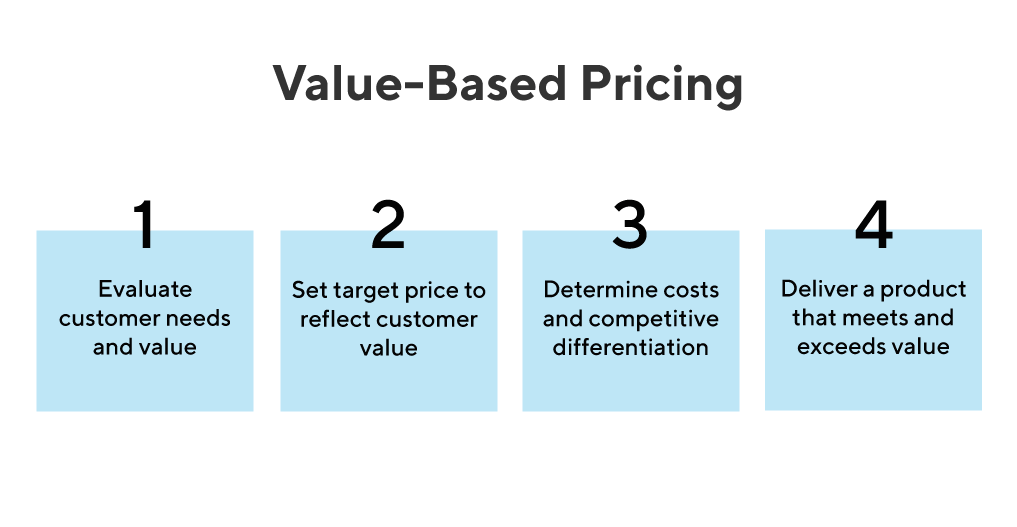
4. Set goals for your product.
Your goals will vary depending on your business and the product. It’s important to set goals with product marketing because you need to have a target to strive towards. Here are some common product marketing goals to include in your strategy:
- Increase in revenue
- Gain customers from competitors
- Go viral on social media
- Receive ‘x’ amount of views on social posts
- Engage with customers
- Boost market share
- Build brand recognition
You may choose to aim for all of the above targets, or just select a couple to focus on. For example, if your business doesn’t rely on social media to attract customers, gaining ‘x’ views on your posts isn’t a must. However, nearly every business will have the goal of increasing revenue when releasing new products.
What’s more, your goals should be written as SMART goals.
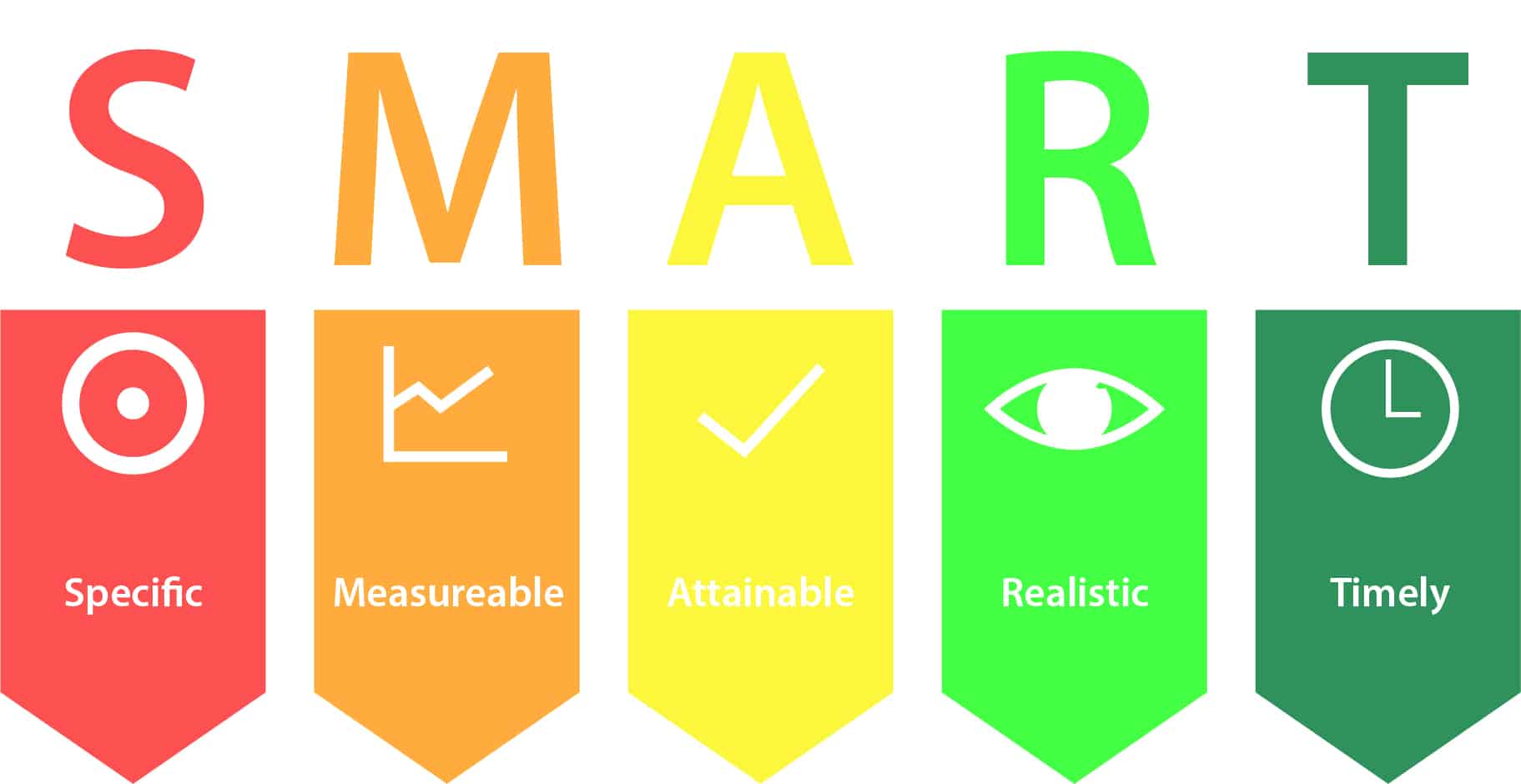
Writing a goal in this format covers the following:
- What do you want to do?
- How will you reach it?
- Is it in your power to accomplish it?
- Can you realistically achieve it?
- What time frame will you need to achieve it?
Here’s an example of a SMART goal for “I want to build our brand’s social pages to sell more of our new product’:
Specific – Lots of customers access the brand through social media. I want to build the brand’s social pages through adverts and organic posts.
Measurable – I’d like to achieve a 20% follower increase rate through paid adverts and competitions within the next quarter.
Attainable – Competitors have managed to grow their social pages by advertising a similar product to the same target audience.
Realistic – We have a team of social media experts to help grow the pages, and boost awareness around the new product.
Timely – We will launch the product, and immediately start marketing with targeted ads to reach 20% follower increase in the next quarter.
As you can see, the goal is realistic and relevant to the business. Formatting goals in this way can give you a better chance of actually achieving them because you’ve got a detailed plan in place. The team should be aware of your SMART goals and the role they play to make them happen.

5. Establish a launch plan.
Product marketing management (PMM) teams need to create a detailed and effective launch plan. This is the most exciting part of the product marketing strategy because it’s where everything comes together. As a product marketer, there are two main factors to consider for the launch plan – internal product launch, and external product launch.
The internal product launch refers to the company’s process for the product launch, and external product launch is all about what goes on outside the company, with your customers and target audience.
Internal launch plan
Your PPM team will pull together to let everyone in the business know their role for the product launch. The most important element is informing your employees on the product, no matter what department they’re in. This helps maintain consistent product messaging across the board and ensures that customers receive accurate and relevant information about the product.
It would help if you briefed your employees on the following:
- What the product is
- The product’s uses and benefits
- Your target audience
- Product demo information where applicable
- Your positioning and messaging
- The product roadmap
- The goals for your product
- The product’s features
- Pricing
- Product-marketing launch plan
Internal launch plan communications to employees can be done via a presentation or video conference. If your company operates globally, it may be hard to get everyone in the same room to talk about the product launch.
Using software like RingCentral can help with this. With its screen sharing feature, you can create a presentation and present it to your employees through a video conference call. Employees from across the globe can watch with the HD video quality. They can also ask questions through its team messaging feature to ensure everyone’s on the same page.
External launch plan
If your brand is already established, you may want to create a buzz about your great product before it even hits the shelves. This is part of your external launch plan. You’re marketing your product launch, so your customers and target audience learn more about what you’re selling.
You will need to figure out where you’re going to focus your marketing. Here’s an example of some avenues you may want to explore:
- Social media channels
- Product reviews
- Product launch event
- Press and blogs
- Your website
- Promotional campaign online and/or in-store
The goal is to educate your customers and target audience about your new product. You may wish to use several channels to do this or focus your attention on just one. In the end, your audience should be made to feel like they need your product and be inclined to make a purchase.
What Does a Product Marketing Team Look Like?
You may expect a product marketer to fit within the marketing team. But in actuality, that’s not always the case. Below are the results of a survey by the Product Marketing Alliance, showing where product marketers sit.
Though most product marketers sit within the marketing team, it’s also evident that some businesses feel they’re useful in other areas, such as product development and business development. Cross-team collaboration like this may improve the customer experience.
The roles within the product marketing team can vary depending on your company size. Typically, here’s what a marketing team looks like:
- Head of Product Marketing
The head of product marketing oversees all product marketing within the company, and may be a vice president or company director, or even the CEO. They’re in charge of product management, product development, and delegate tasks within the team.
- Product Marketing Team Leader
The product marketing team leader usually has a technical marketing background or holds a senior position to other product marketing managers.
- Product Marketing Manager
Product management teams can have multiple product marketing managers. They’re assigned to their own products or services of the business. They track competitors, identify industry trends, and work with analysts to understand the target audience.
- Content Marketing Manager
Content marketing managers maintain the website and social media channels. They create and post unique content to sell the products.
- Sales Enablement Manager
They act as a liaison for the marketing and sales department to come together and sell the product. They also have knowledge of content creation and close deals within the sales pipeline.
How to Measure the Effectiveness of Your Product Marketing Process
To measure your product marketing process’s effectiveness, you need to look at your KPIs (key performance indicators). Each KPI will give you an insight into how your product performed and the targets it met. Some key measures include:
1. Sales effectiveness.
Measuring how well your team’s time was spent during the product marketing process is crucial. Analytics tools will show how customers moved along the sales funnel, and whether certain actions from the sales team boosted this. You will discover which assets helped you the most, and the buyer’s journey to checkout.
2. Win rates.
Measuring overall win rates will allow you to uncover strengths and new opportunities. This refers to how well you perform against your competitors. Study the win rates in your target market as determined by your product marketing efforts, and reflect on moments where you were ahead of your competitors.

3. Product launch metrics.
This is key in seeing how well your target audience responded to your product within the first few days of release. Product launch metrics include:
- Number of product demos requested
- Website landing page views
- New customers or upgrades
- Press coverage
Set a timeframe for when you want to review these metrics, it may be two weeks after launch, or two months.
4. Product adoption.
How many customers used your product? You should work with your team to track metrics and improve product adoption rates. You can tell how excited consumers are by your product by looking at whether they purchased it, upgraded, shared it, or interacted with your website.
5. Customer retention.
Competitors are going to try and win over your customers. You can tell if your product marketing techniques work if your customer retention is high, meaning they’re choosing you over your rivals.
Product Marketing and Campaign Examples
When looking into what makes a product-marketing campaign great, there are a few factors to consider. How does the brand let the consumer know it’s the best at what it does? And how does it build brand awareness around its products? Let’s review some product marketing and campaign examples.
RingCentral
With more people working remotely than ever, RingCentral has placed itself at the forefront of the work-from-anywhere movement.
This all-in-one solution to working from home has been vital for many. It includes video conferencing, audio calling, and team messaging – all in one, convenient place. Not only this, but you can also:
- Integrate apps
- HD video call
- Conference with up to 100 participants
- Get 24/7 customer service
- Analyse sales data
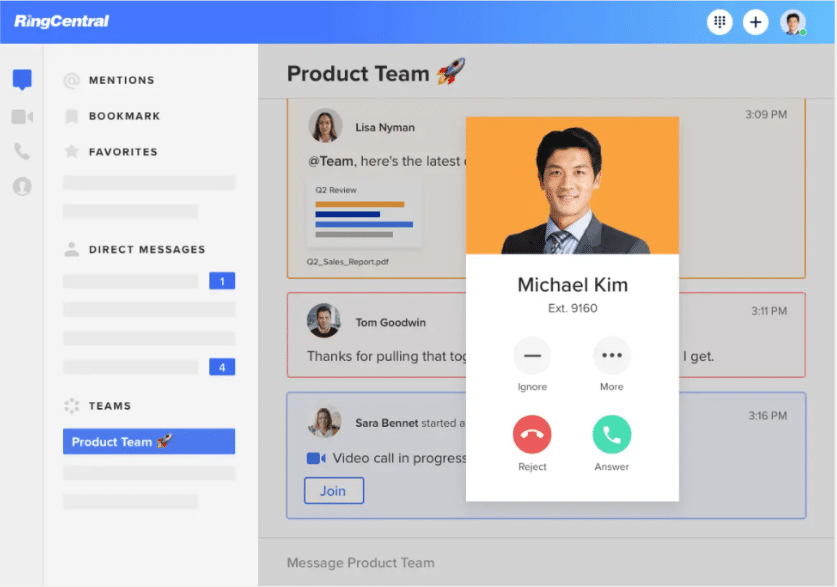
It was recently named a Leader in the 2020 Gartner Magic Quadrant for Unified Communications as a Service (for the sixth year in a row). This demonstrates that they’re firmly established within the market, and show no signs of slowing down.
As we’ve discovered, one of the most effective ways of product marketing is through customer reviews and case studies.
RingCentral has dedicated a page on their website to case studies and a Youtube playlist entitled ‘Customer Stories’. Here, they promote their brand to their target audience and demonstrate to potential customers why so many businesses love using RingCentral. This has been crucial in building brand awareness and ultimately, selling their product.
Nike
Nike dominates the sportswear market. And with simple, yet effective, advertising, it’s easy to see why.
Their “You Can’t Stop…” campaign has featured videos such as ‘You Can’t Stop Us’, ‘You Can’t Stop Sisters’, and ‘You Can’t Stop LA’. And what do all of these campaigns have in common? Top sportspeople and women, athletes, musicians, and other celebrities with huge social followings featuring videos.
In their most viewed You Can’t Stop campaign video, currently standing at over 116 million views, Nike comment, “There’s a reason we love comeback stories. Watching LeBron James, Serena Williams and Tiger Woods, we see ourselves in them – our resolve, our grit, our hope. Now, more than ever, we need these stories to remind us what we’re capable of.”
Of course, the message is strong and powerful. But ultimately, it’s all about selling their product, and their new product lines, to be exact.

Amazon Alexa
Amazon dominates the market when it comes to eCommerce. But they’ve also done well at diversifying with other products, such as Amazon Prime Video and the Alexa voice assistant.
This virtual assistant was first released in 2014, and now, it’s become synonymous with smart home speakers. And, the Alexa now has a higher market share than any other smart home hub.
However, there were (and still are) many sceptics when it comes to smart speakers. That’s why Amazon launched a campaign directed at those who are new to voice technology. The adverts, created by Droga5 London, demonstrate Alexa’s ability to help everyday people around their homes.
The executive director of Droga5 London said: “Even mundane tasks, such as switching on lights, changing tracks or rewinding a film, are made to feel epic and magical when you can control them using nothing but your voice… and Alexa, of course.”
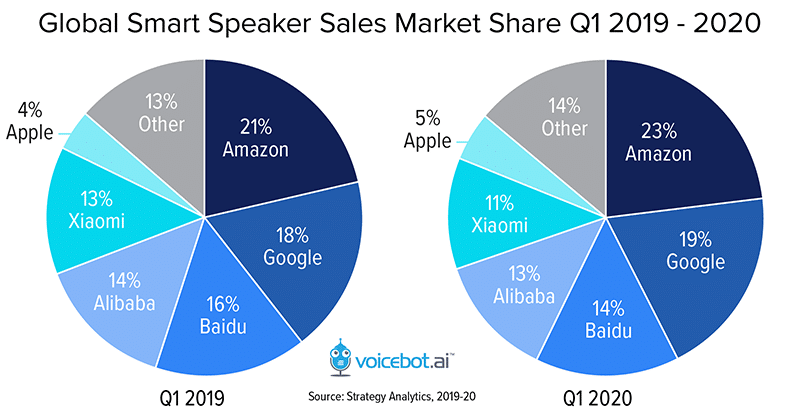
Ivy Park
Singer Beyonce teamed up with Adidas to create her Ivy Park brand. The launch was on October 29th 2020, and social media was flooded with her PR package posts. Not only did they send PR boxes to fellow celebrities and influencers, but also some loyal Beyonce fans.
They then recorded their reactions to receiving the package and posted them to social media. The response prompted plenty of press and articles such as this one from Pop Sugar, bringing even more hype to the brand.
This clever campaign of sending over-the-top PR packages to friends and fans helped to establish this relatively unknown brand within the sportswear field practically overnight.

How Will You Implement Product Marketing?
We’ve given you all the tools you need to understand what product marketing is, and how you can now implement it in your business. You should utilise your product marketing team’s skill sets to establish a solid plan for growing your business through product marketing. Remember to:
- Conduct market research
- Find your target audience’s wants and needs
- Create a strong marketing strategy
- Analyse customer data after launch
Whether you’re looking to re-launch a product with a stronger brand message behind it or challenge your competitor by releasing an upgraded version of their product, ensure you’re using a product marketing strategy that works for you.
Get details on the security and trust built into RingCentral products and services.Download the white paper
Originally published Jan 22, 2021, updated Jan 17, 2023

